手机是有两个内存的。2G和16G同时出现在一个手机中,2G是指运行内存,16G是指存储内存。
手机的内存,分两种,一个是存储内存,相当于电脑的硬盘,一般手机参数里超过4G的都是指这个。存储内存是可以扩展的。如果手机支持插卡就可以扩展。
另一个是运行内存,相当于电脑的内存条。这个是不能扩展的。基本上都在2GB以内,少量的可以达到3G或4G。
我们先来考虑这样一个问题:
打开手机设置,选择应用管理,选择任意一个App,然后你会看到两个按钮,一个是清除缓存,另一个是清除数据,那么当我们点击清除缓存的时候清除的是哪里的数据?当我们点击清除数据的时候又是清除的哪里的数据?读完本文相信你会有答案。
在Android开发中我们常常听到这样几个概念,内存,内部存储,外部存储,很多人常常将这三个东西搞混,那么我们今天就先来详细说说这三个东西是怎么回事?
内存,我们在英文中称作memory,内部存储,我们称为InternalStorage,外部存储我们称为ExternalStorage,这在英文中本不会产生歧义,但是当我们翻译为中文之后,前两个都简称为内存,于是,混了。
那么究竟什么是内部存储什么是外部存储呢?
首先我们打开DDMS,有一个File Explorer,如下:
这里有三个文件夹需要我们重视,一个是data,一个是mnt,一个是storage,我们下面就详细说说这三个文件夹。
1.内部存储
data文件夹就是我们常说的内部存储,当我们打开data文件夹之后(没有root的手机不能打开该文件夹),里边有两个文件夹值得我们关注,如下:
一个文件夹是app文件夹,还有一个文件夹就是data文件夹,app文件夹里存放着我们所有安装的app的apk文件,其实,当我们调试一个app的时候,可以看到控制台输出的内容,有一项是uploading ……就是上传我们的apk到这个文件夹,上传成功之后才开始安装。另一个重要的文件夹就是data文件夹了,这个文件夹里边都是一些包名,打开这些包名之后我们会看到这样的一些文件:
1.data/data/包名/shared_prefs
2.data/data/包名/databases
3.data/data/包名/files
4.data/data/包名/cache
如果打开过data文件,应该都知道这些文件夹是干什么用的,我们在使用sharedPreferenced的时候,将数据持久化存储于本地,其实就是存在这个文件中的xml文件里,我们App里边的数据库文件就存储于databases文件夹中,还有我们的普通数据存储在files中,缓存文件存储在cache文件夹中,存储在这里的文件我们都称之为内部存储。
2.外部存储
外部存储才是我们平时操作最多的,外部存储一般就是我们上面看到的storage文件夹,当然也有可能是mnt文件夹,这个不同厂家有可能不一样。
一般来说,在storage文件夹中有一个sdcard文件夹,这个文件夹中的文件又分为两类,一类是公有目录,还有一类是私有目录,其中的公有目录有九大类,比如DCIM、DOWNLOAD等这种系统为我们创建的文件夹,私有目录就是Android这个文件夹,这个文件夹打开之后里边有一个data文件夹,打开这个data文件夹,里边有许多包名组成的文件夹。
说到这里,我想大家应该已经可以分清楚什么是内部存储什么是外部存储了吧?好,分清楚之后我们就要看看怎么来操作内部存储和外部存储了。
#3.操作存储空间
首先,经过上面的分析,大家已经明白了,什么是内部存储,什么是外部存储,以及这两种存储方式分别存储在什么位置,一般来说,我们不会自己去操作内部存储空间,没有root权限的话,我们也没法操作内部存储空间,事实上内部存储主要是由系统来维护的。不过在代码中我们是可以访问到这个文件夹的。由于内部存储空间有限,在开发中我们一般都是操作外部存储空间,Google官方建议我们App的数据应该存储在外部存储的私有目录中该App的包名下,这样当用户卸载掉App之后,相关的数据会一并删除,如果你直接在/storage/sdcard目录下创建了一个应用的文件夹,那么当你删除应用的时候,这个文件夹就不会被删除。
经过以上的介绍,我们可以总结出下面一个表格:
一目了然,什么是内部存储,什么是外部存储。
如果按照路径的特征,我们又可以将文件存储的路径分为两大类,一类是路径中含有包名的,一类是路径中不含有包名的,含有包名的路径,因为和某个App有关,所以对这些文件夹的访问都是调用Context里边的方法,而不含有包名的路径,和某一个App无关,我们可以通过Environment中的方法来访问。如下图:
大家看到,有包名的路径我们都是调用Context中的方法来获得,没有包名的路径,我们直接调用Environment中的方法获得,那么其中有两个方法需要传入一个String类型的参数,这个参数我们使用了Environment中的常量,参数的意思是我们要访问这个路径下的哪个文件夹,比如getExternalFilesDir方法,我们看看它的源码:
/**
*
* @param type The type of files directory to return. May be null for
* the root of the files directory or one of
* the following Environment constants for a subdirectory:
* {@link android.os.Environment#DIRECTORY_MUSIC},
* {@link android.os.Environment#DIRECTORY_PODCASTS},
* {@link android.os.Environment#DIRECTORY_RINGTONES},
* {@link android.os.Environment#DIRECTORY_ALARMS},
* {@link android.os.Environment#DIRECTORY_NOTIFICATIONS},
* {@link android.os.Environment#DIRECTORY_PICTURES}, or
* {@link android.os.Environment#DIRECTORY_MOVIES}.
*
* @return The path of the directory holding application files
* on external storage. Returns null if external storage is not currently
* mounted so it could not ensure the path exists; you will need to call
* this method again when it is available.
*
* @see #getFilesDir
* @see android.os.Environment#getExternalStoragePublicDirectory
*/
@Nullable
public abstract File getExternalFilesDir(@Nullable String type);
它的注释非常多,我这里只列出其中一部分,我们看到,我们可以访问files文件夹下的Music文件夹、Movies文件夹等等好几种。
说到这里,我想大家对内部存储、外部存储该有了一个清晰的认识了吧。我们在开发中,不建议往内部存储中写太多的数据,毕竟空间有限。外部存储在使用的时候最好能够将文件存放在私有目录下,这样有利于系统维护,也避免用户的反感。
现在我们再来看看我们一开始提出的问题,当我们点击清除数据的时候清除的是哪里的数据呢?毫无疑问,当然是内部存储目录中相应的files和cache文件夹中的文件和外部存储中相应的files和cache文件夹中的文件,至于这些文件夹的路径我想你应该已经明白了。
最后提供一个工具类:
public class SDCardHelper {
// 判断SD卡是否被挂载
public static boolean isSDCardMounted() {
// return Environment.getExternalStorageState().equals("mounted");
return Environment.getExternalStorageState().equals(
Environment.MEDIA_MOUNTED);
}
// 获取SD卡的根目录
public static String getSDCardBaseDir() {
if (isSDCardMounted()) {
return Environment.getExternalStorageDirectory().getAbsolutePath();
}
return null;
}
// 获取SD卡的完整空间大小,返回MB
public static long getSDCardSize() {
if (isSDCardMounted()) {
StatFs fs = new StatFs(getSDCardBaseDir());
long count = fs.getBlockCountLong();
long size = fs.getBlockSizeLong();
return count * size / 1024 / 1024;
}
return 0;
}
// 获取SD卡的剩余空间大小
public static long getSDCardFreeSize() {
if (isSDCardMounted()) {
StatFs fs = new StatFs(getSDCardBaseDir());
long count = fs.getFreeBlocksLong();
long size = fs.getBlockSizeLong();
return count * size / 1024 / 1024;
}
return 0;
}
// 获取SD卡的可用空间大小
public static long getSDCardAvailableSize() {
if (isSDCardMounted()) {
StatFs fs = new StatFs(getSDCardBaseDir());
long count = fs.getAvailableBlocksLong();
long size = fs.getBlockSizeLong();
return count * size / 1024 / 1024;
}
return 0;
}
// 往SD卡的公有目录下保存文件
public static boolean saveFileToSDCardPublicDir(byte[] data, String type, String fileName) {
BufferedOutputStream bos = null;
if (isSDCardMounted()) {
File file = Environment.getExternalStoragePublicDirectory(type);
try {
bos = new BufferedOutputStream(new FileOutputStream(new File(file, fileName)));
bos.write(data);
bos.flush();
return true;
} catch (Exception e) {
e.printStackTrace();
} finally {
try {
bos.close();
} catch (IOException e) {
// TODO Auto-generated catch block
e.printStackTrace();
}
}
}
return false;
}
// 往SD卡的自定义目录下保存文件
public static boolean saveFileToSDCardCustomDir(byte[] data, String dir, String fileName) {
BufferedOutputStream bos = null;
if (isSDCardMounted()) {
File file = new File(getSDCardBaseDir() + File.separator + dir);
if (!file.exists()) {
file.mkdirs();// 递归创建自定义目录
}
try {
bos = new BufferedOutputStream(new FileOutputStream(new File(file, fileName)));
bos.write(data);
bos.flush();
return true;
} catch (Exception e) {
e.printStackTrace();
} finally {
try {
bos.close();
} catch (IOException e) {
// TODO Auto-generated catch block
e.printStackTrace();
}
}
}
return false;
}
// 往SD卡的私有Files目录下保存文件
public static boolean saveFileToSDCardPrivateFilesDir(byte[] data, String type, String fileName, Context context) {
BufferedOutputStream bos = null;
if (isSDCardMounted()) {
File file = context.getExternalFilesDir(type);
try {
bos = new BufferedOutputStream(new FileOutputStream(new File(file, fileName)));
bos.write(data);
bos.flush();
return true;
} catch (Exception e) {
e.printStackTrace();
} finally {
try {
bos.close();
} catch (IOException e) {
// TODO Auto-generated catch block
e.printStackTrace();
}
}
}
return false;
}
// 往SD卡的私有Cache目录下保存文件
public static boolean saveFileToSDCardPrivateCacheDir(byte[] data, String fileName, Context context) {
BufferedOutputStream bos = null;
if (isSDCardMounted()) {
File file = context.getExternalCacheDir();
try {
bos = new BufferedOutputStream(new FileOutputStream(new File(file, fileName)));
bos.write(data);
bos.flush();
return true;
} catch (Exception e) {
e.printStackTrace();
} finally {
try {
bos.close();
} catch (IOException e) {
// TODO Auto-generated catch block
e.printStackTrace();
}
}
}
return false;
}
// 保存bitmap图片到SDCard的私有Cache目录
public static boolean saveBitmapToSDCardPrivateCacheDir(Bitmap bitmap, String fileName, Context context) {
if (isSDCardMounted()) {
BufferedOutputStream bos = null;
// 获取私有的Cache缓存目录
File file = context.getExternalCacheDir();
try {
bos = new BufferedOutputStream(new FileOutputStream(new File(file, fileName)));
if (fileName != null && (fileName.contains(".png") || fileName.contains(".PNG"))) {
bitmap.compress(Bitmap.CompressFormat.PNG, 100, bos);
} else {
bitmap.compress(Bitmap.CompressFormat.JPEG, 100, bos);
}
bos.flush();
} catch (Exception e) {
e.printStackTrace();
} finally {
if (bos != null) {
try {
bos.close();
} catch (IOException e) {
e.printStackTrace();
}
}
}
return true;
} else {
return false;
}
}
// 从SD卡获取文件
public static byte[] loadFileFromSDCard(String fileDir) {
BufferedInputStream bis = null;
ByteArrayOutputStream baos = new ByteArrayOutputStream();
try {
bis = new BufferedInputStream(new FileInputStream(new File(fileDir)));
byte[] buffer = new byte[8 * 1024];
int c = 0;
while ((c = bis.read(buffer)) != -1) {
baos.write(buffer, 0, c);
baos.flush();
}
return baos.toByteArray();
} catch (Exception e) {
e.printStackTrace();
} finally {
try {
baos.close();
bis.close();
} catch (IOException e) {
e.printStackTrace();
}
}
return null;
}
// 从SDCard中寻找指定目录下的文件,返回Bitmap
public Bitmap loadBitmapFromSDCard(String filePath) {
byte[] data = loadFileFromSDCard(filePath);
if (data != null) {
Bitmap bm = BitmapFactory.decodeByteArray(data, 0, data.length);
if (bm != null) {
return bm;
}
}
return null;
}
// 获取SD卡公有目录的路径
public static String getSDCardPublicDir(String type) {
return Environment.getExternalStoragePublicDirectory(type).toString();
}
// 获取SD卡私有Cache目录的路径
public static String getSDCardPrivateCacheDir(Context context) {
return context.getExternalCacheDir().getAbsolutePath();
}
// 获取SD卡私有Files目录的路径
public static String getSDCardPrivateFilesDir(Context context, String type) {
return context.getExternalFilesDir(type).getAbsolutePath();
}
public static boolean isFileExist(String filePath) {
File file = new File(filePath);
return file.isFile();
}
// 从sdcard中删除文件
public static boolean removeFileFromSDCard(String filePath) {
File file = new File(filePath);
if (file.exists()) {
try {
file.delete();
return true;
} catch (Exception e) {
return false;
}
} else {
return false;
}
}
}
手机内存的官方路径的:是
String path=Environment.getExternalStorageDirectory().getAbsolutePath();
因为安卓以不安全为由不鼓励应用将文件写入sd卡,自4.0以来api不提供sd卡的固定路径。sd卡路径根据厂家定制各不相同。比如三星的/storage/extSdCard,比如小米的/storage/sdcard1.调用getExternalStorageDirectory返回的也不会是外置sd卡目录而是手机内存。
建议将文件存在手机内存或/data/data中。如果一定要获取sd卡路径。可以尝试在/mnt或/storage中遍历里面的文件夹,根据手机内存和sd卡一些细微的不同,比如sd卡上有LOST.DIR,找出sd卡路径。但是非官方的方法很难保证对于每一种定制的系统这种方法都奏效。
Android数据访问存储之内存读写
Android数据存储之内存读写的两大内存
1、手机内存数据读写
getFileDir( ) : 得到当前app在手机内存存储数据的位置 /data/data/当前app包名/files
getCacheDir( ) : 得到当前app在手机内存存储数据的位置/data/data/当前app包名/cache
openFileInput(String name) : 直接得到/data/data/当前app包名/files/name文件的输入流
openFileOutput(String name,int mode) : 直接得到/data/data/当前app包名/files/name文件的输出流,mode为写入文件时的权限
2、sdcard数据读写
Environment.getExternalStorageDirectory( ) : 得到当前app所在手机的sdcard位置/storage/sdcard
Environment.getExternalStoragePublicDirectory(String type) : 得到当前app所在手机的sdcard位置下的公共子文件夹/storage/sdcard/…
Android数据存储之内存读写应用实例
布局文件 activity_main.xml
<LinearLayout xmlns:android="http://schemas.android.com/apk/res/android"
xmlns:tools="http://schemas.android.com/tools"
android:layout_width="match_parent"
android:layout_height="match_parent"
android:orientation="vertical"
android:paddingBottom="@dimen/activity_vertical_margin"
android:paddingLeft="@dimen/activity_horizontal_margin"
android:paddingRight="@dimen/activity_horizontal_margin"
android:paddingTop="@dimen/activity_vertical_margin"
tools:context=".MainActivity" >
<TextView
android:id="@+id/tv_main_memerysize"
android:layout_width="match_parent"
android:layout_height="80dip"
android:textSize="20sp"
android:textColor="#6666ff"
android:text="内存大小"/>
<TextView
android:id="@+id/tv_main_sdcard"
android:layout_width="match_parent"
android:layout_height="40dip"
android:textSize="20sp"
android:textColor="#ff6666"
android:text="SDCard存在否"/>
<TextView
android:id="@+id/tv_main_sdcardsize"
android:layout_width="match_parent"
android:layout_height="80dip"
android:textSize="20sp"
android:textColor="#ff6666"
android:text="SDCard内存大小"/>
<EditText
android:id="@+id/et_main_content"
android:layout_width="match_parent"
android:layout_height="0dip"
android:layout_weight="1"
android:textSize="20sp"
android:text="测试写入内存:\n将这里的文本信息保存到内存文件 testmemeryio.txt"/>
<Button
android:id="@+id/btn_main_writememery"
android:layout_width="match_parent"
android:layout_height="wrap_content"
android:text="写入内存"/>
<Button
android:id="@+id/btn_main_writesdcard"
android:layout_width="match_parent"
android:layout_height="wrap_content"
android:text="写入sdcard"/>
</LinearLayout>
示例代码 MainActivity.Java
package com.yihui.iomemery;
import java.io.FileOutputStream;
import java.io.IOException;
import android.annotation.SuppressLint;
import android.app.Activity;
import android.content.Context;
import android.os.Bundle;
import android.os.Environment;
import android.os.StatFs;
import android.text.format.Formatter;
import android.view.View;
import android.view.View.OnClickListener;
import android.widget.Button;
import android.widget.EditText;
import android.widget.TextView;
import android.widget.Toast;
public class MainActivity extends Activity implements OnClickListener {
private TextView tv_main_memerysize;
private TextView tv_main_sdcard;
private TextView tv_main_sdcardsize;
private EditText et_main_content;
private Button btn_main_writememery;
private Button btn_main_writesdcard;
private boolean sdcardMount = false;
@Override
protected void onCreate(Bundle savedInstanceState) {
super.onCreate(savedInstanceState);
setContentView(R.layout.activity_main);
tv_main_memerysize = (TextView) findViewById(R.id.tv_main_memerysize);
tv_main_sdcard = (TextView) findViewById(R.id.tv_main_sdcard);
tv_main_sdcardsize = (TextView) findViewById(R.id.tv_main_sdcardsize);
et_main_content = (EditText) findViewById(R.id.et_main_content);
btn_main_writememery = (Button) findViewById(R.id.btn_main_writememery);
btn_main_writesdcard = (Button) findViewById(R.id.btn_main_writesdcard);
btn_main_writememery.setOnClickListener(this);
btn_main_writesdcard.setOnClickListener(this);
//判断sdcard是否已安装
tv_main_sdcard.setText("sdcard未安装");
if(Environment.getExternalStorageState().equals(Environment.MEDIA_MOUNTED)){
sdcardMount = true;
tv_main_sdcard.setText("sdcard已安装");
}
//得到sdcard和内存的大小及可用容量
if(sdcardMount){
tv_main_sdcardsize.setText("sdcard" + getStorgeFileSize(Environment.getExternalStorageDirectory().getPath()));
}else {
tv_main_sdcardsize.setText("sdcard总内存:0MB; 可用内存:0MB");
}
tv_main_memerysize.setText("手机" + getStorgeFileSize(Environment.getDataDirectory().getPath()));
}
/* 两个按钮的监听事件,将内容写入内存文件testmemeryio.txt */
@Override
public void onClick(View v) {
String text = et_main_content.getText().toString();
boolean success = true;
switch (v.getId()) {
case R.id.btn_main_writesdcard: //写入sdcard
FileOutputStream fos = null;
try {
fos = new FileOutputStream(Environment.getExternalStorageDirectory().getPath() + "/m.txt");
fos.write(text.getBytes("utf-8"));
fos.flush();
} catch (IOException e) {
success = false;
e.printStackTrace();
} finally {
if(fos != null){
try {
fos.close();
fos = null;
} catch (IOException e) {
e.printStackTrace();
}
}
}
Toast.makeText(MainActivity.this, success == true ? "写入sdcard文件成功" : "写入sdcard文件失败", 0).show();
break;
case R.id.btn_main_writememery: //写入内存
FileOutputStream openFileOutput = null;
try {
//使用openFileOutput()函数,直接在/data/data/包名/files/目录下创建文件
openFileOutput = openFileOutput("testmemeryio.txt", Context.MODE_PRIVATE); //私有模式写文件
openFileOutput.write(text.getBytes("utf-8"));
openFileOutput.flush();
} catch (IOException e) {
success = false;
e.printStackTrace();
} finally {
if(openFileOutput != null){
try {
openFileOutput.close();
openFileOutput = null;
} catch (IOException e) {
e.printStackTrace();
}
}
}
Toast.makeText(MainActivity.this, success == true ? "写入内存文件成功" : "写入内存文件失败", 0).show();
break;
default:
break;
}
}
/* 取得内存文件空间大小及可用大小 */
@SuppressLint("NewApi") private String getStorgeFileSize(String path){
String fileSizeDesc = null;
StatFs statFs = new StatFs(path); //获得磁盘状态的对象
long blockSizeLong = statFs.getBlockSizeLong(); //获得磁盘一个扇区的大小
long blockCountLong = statFs.getBlockCountLong(); //获得磁盘空间总的扇区数
long availableBlocksLong = statFs.getAvailableBlocksLong(); //获得磁盘空间总的可用扇区数
fileSizeDesc = "总内存:" + Formatter.formatFileSize(MainActivity.this, blockSizeLong*blockCountLong)
+ "; 可用内存:" + Formatter.formatFileSize(MainActivity.this, blockSizeLong*availableBlocksLong);
return fileSizeDesc;
}
}
注意:因为要读写SDCard,所以在项目里面的AndroidManifest.xml功能清单文件里面添加读写SDCard的权限
......
<uses-sdk
android:minSdkVersion="8"
android:targetSdkVersion="19" />
<uses-permission android:name="android.permission.READ_EXTERNAL_STORAGE"/> <!-- sdcard读权限 -->
<uses-permission android:name="android.permission.WRITE_EXTERNAL_STORAGE"/> <!-- sdcard写权限 -->
......
运行效果:
在File Explorer下可以看到
/data/data/com.yihui.iomemery/files/testmemeryio.txt文件,且写入的内容就是UI上面文本框里面的内容
/storage/sdcard/m.txt文件,且写入的内容也是UI上面文本框里面的内容
Android数据存储之读写模式(读写权限)
Android是基于Linux操作系统的,所以Android的文件访问权限与Linux系统的文件访问权限是一致的,具体参考下图说明
1、Android数据访问权限实现方式
Context类的public abstract FileOutputStream openFileOutput(String name, int mode)
2、其中mode就是文件访问权限模式,主要4种模式
Context.MODE_PRIVATE:私有模式(默认模式),只能被应用本身和同一群组的人访问;写入的内容覆盖原文件内容
Context.MODE_APPEND: 追加模式也是私有模式,只能被应用本身和同一群组的人访问;如果文件存在就追加内容,如果文件不存在就新建文件并写入内容
Context.MODE_WORLD_READABLE: 所有人可读权限
Context.MODE_WORLD_WRITEABLE:所有人可写权限
也可通过多个组合同时拥有多个读写权限,Context.MODE_WORLD_READABLE + Context.MODE_WORLD_WRITEABLE表示所有人可读+可写
Android实现内存中数据保存到sdcard的方法
public static void writeToSdCard(String s) {
try {
File dst = new File("/sdcard/test_sensor/" + mName + ".txt");
File parent = dst.getParentFile();
if(!parent.exists()) {
parent.mkdirs();
}
FileOutputStream outStream = new FileOutputStream(dst, true);
OutputStreamWriter writer = new OutputStreamWriter(outStream, "gb2312");
writer.write(s);
writer.write("\n");
writer.flush();
writer.close();// 记得关闭
outStream.close();
} catch (Exception e) {
Log.i("test result", "file write error");
e.printStackTrace();
}
}








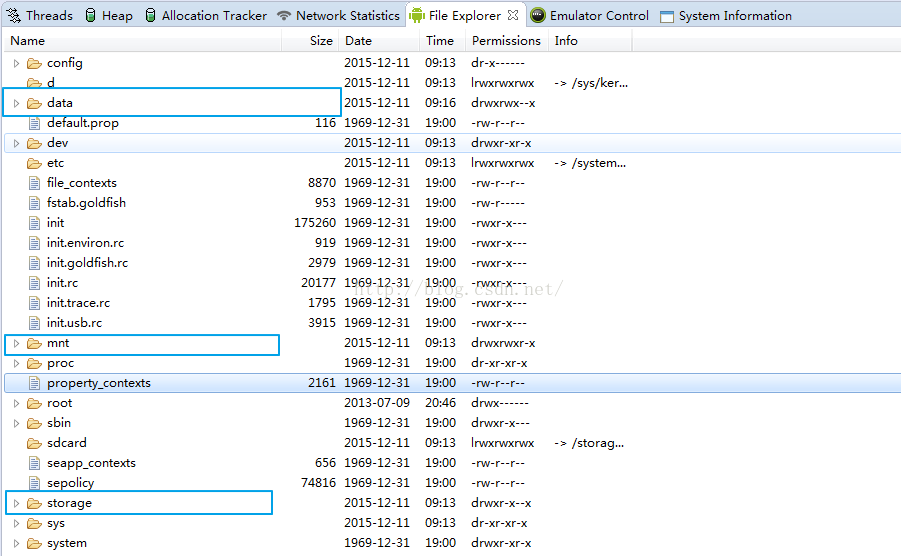
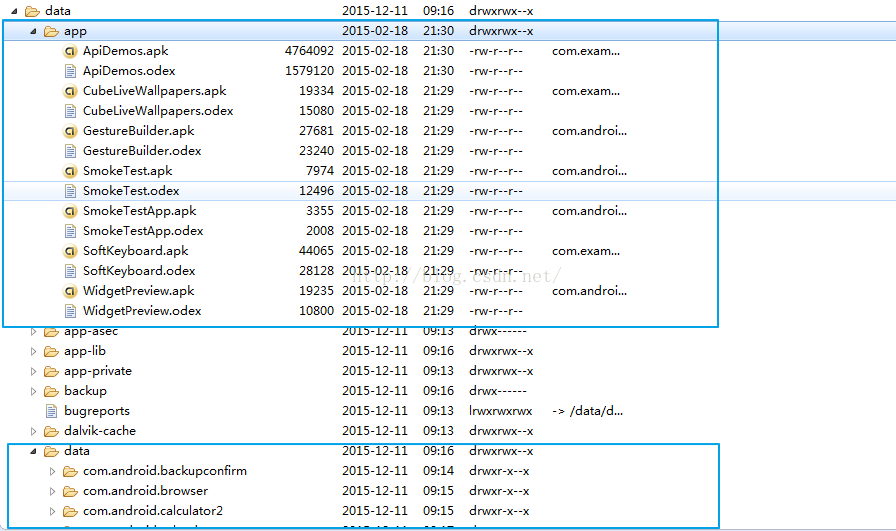
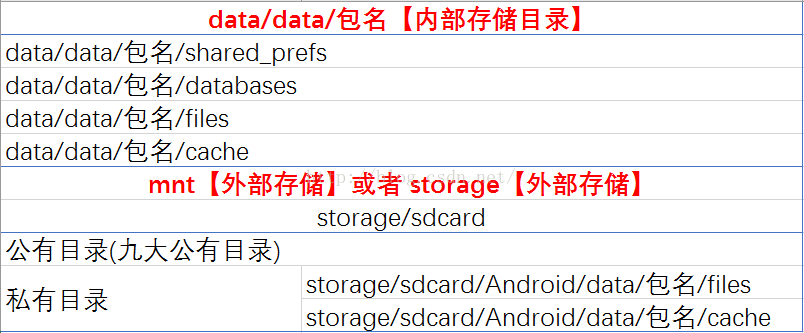
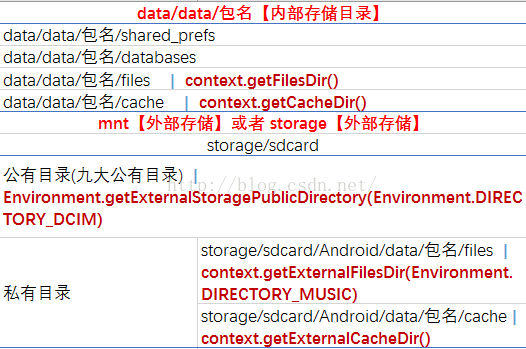
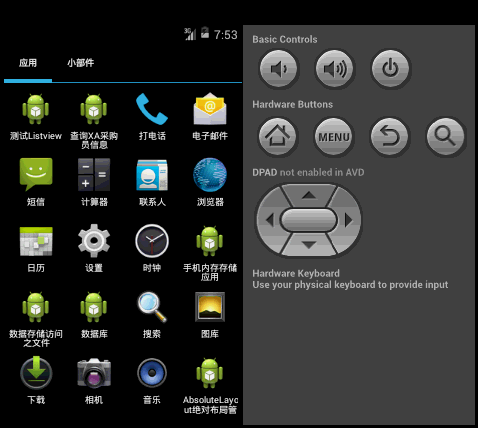
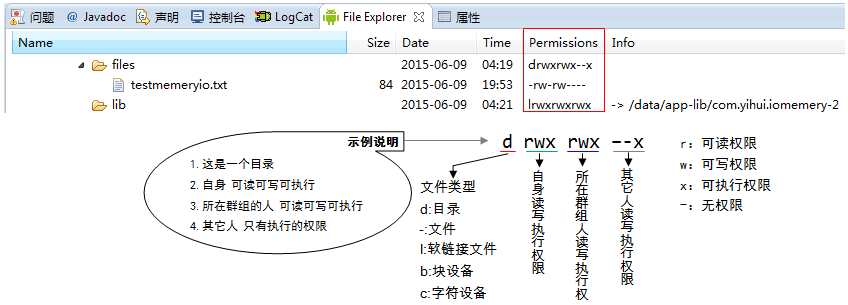

















 被折叠的 条评论
为什么被折叠?
被折叠的 条评论
为什么被折叠?








